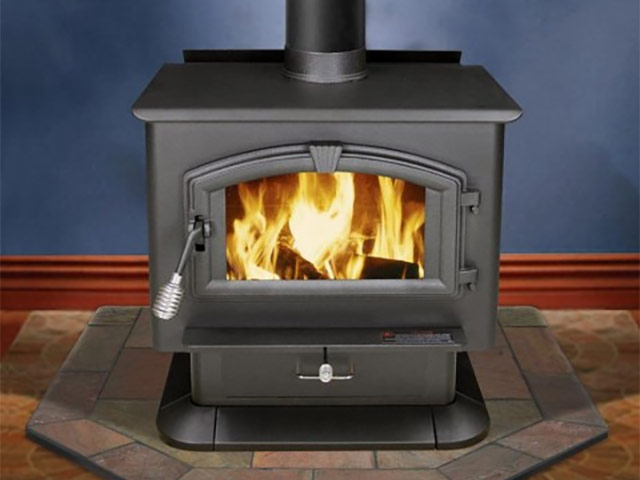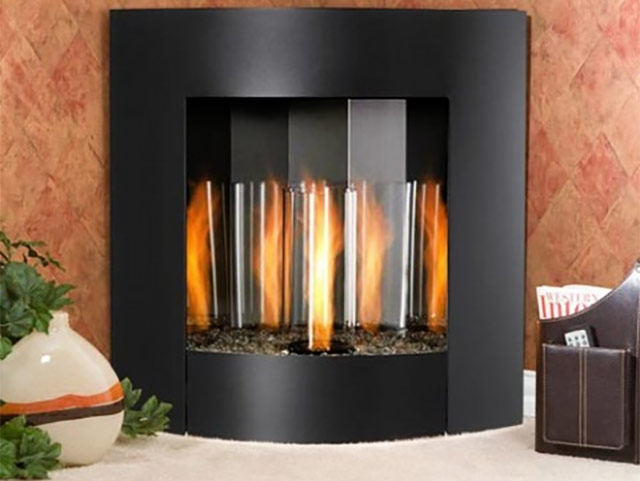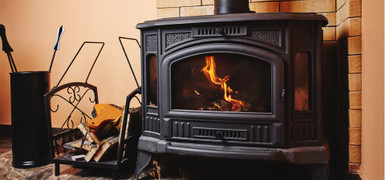Jun 17th 2020
About Old-Style Heatilator Fireplaces
Heatilator fireplaces, also known as "old-style zero clearance fireplaces", are a combination of heater and ventilator and are by their nature, fireplaces that circulate air. Old-Style Heatilator Fireplaces use a special venting system that draws in cool room air and releases it as warmer air. The air that is in the venting system never goes through the firebox so it doesn't get fouled with ash, smoke, or other unpleasant odors. Instead of pushing air through the firebox, Old-Style Heatilator Fireplaces route air around the firebox and allow it to heat, without any of the drawbacks associated with traditional fireplaces.
Smoke Chamber - The area above the fireplace and below the flue, used to allow smoke to mix and rise into the flue. Because smoke tends to linger here, large deposits of creosote often accumulate here.
Top Air Vent - The top air vent on an Old Style Heatilator Fireplace returns heated air into the room. The cool air enters a vent at the bottom of the Heatilator. The air is then routed around the firebox and heated without any of the drawbacks associated with traditional fireplaces, and then returned into the room through the top air vent.
Blower - Old-Style Heatilator Fireplaces utilize a blower to circulate warm air throughout the room. A blower increases fireplace efficiency by evenly distributing warm air throughout the home which maximizes the performance of your fireplace thereby ensuring that it increases the amount of heat it gives off.
Mantle - A fireplace mantle is a decorative framework around the fireplace. It can include elaborate designs extending to the ceiling.
Firebox - The firebox or fire pit is the part of the fireplace where fuel is combusted, in distinction to the hearth, chimney, mantel, over mantel and flue elements of the total fireplace system. The firebox normally sits on a masonry base at the floor level of the room.

Hearth - The fireproof area directly in front of a fireplace. The inner or outer floor of a fireplace usually made of brick, tile, or stone.
Bottom Air Vent - The bottom air vent on Old-Style Heatilator Fireplaces are where cool room air is drawn into the fireplace. The air is then routed around the firebox and exits through the top air vent where it returns to the room as heated air.
Popular Categories

Fireplace Mantels
Shield your mantle and surrounding woodwork from the heat of the stove with a Homesaver Mantel Shield. It's easy to install, just cut the shield to your size requirements and use the included hardware to attach it to your mantel.
Shop Now
WoodEze Hearth Pads
Hearth pads are sections of fireproof material that can be used underneath wood, pellet and gas stoves to protect floors from sparks and embers and on the back walls behind heating appliances to protect the walls from intense heat.
Shop Now
Fireplace & Hearth
Heatilator fireplaces are available in a variety of styles and various fuel options that appeal to every life style whether it be the simplicity of a gas or electric fireplace or the traditional appeal of a wood burning fireplace..
Shop Now"Old-Style" Heatilator Fireplaces
Old-Style Heatilator Fireplaces are constructed with a double walled fireplace that keeps the heat where it belongs. Since the fire is kept in the fireplace chamber itself, Heatilators are able to avoid the transfer of excess heat into the walls of the home. This is an important safety feature because over time, excess heat transfer can accelerate the degradation of building materials. In extreme cases, heat transfer can contribute to the danger of combustion within the walls of the home. The double walled fireplace will minimize these hazards.
If you are buying a new home, it is possible to purchase a new Heatilator Fireplace. However, if you already own a home and have an existing traditional masonry fireplace, it may be best to continue to use the masonry in conjunction with an updated fireplace unit by updating it with a Heatilator Fireplace insert. A Heatilator Fireplace insert is designed to be placed directly into the masonry which will not only transform the existing fireplace into an efficient heat source but add an updated look to the masonry fireplace.
Heatilators offer many heating options including the most traditional form of fireplace fuel, wood. You can however purchase Heatilator Fireplaces that run on natural gas, liquid propane, pellets and biomass, or electric log sets. Gas operated Heatilators are considered to be more efficient than wood burning Heatilator Fireplaces due to the natural waste of energy associated with burning wood.
Efficiency alone is not all that matters when choosing the right Heatilator Fireplace. Some homeowners enjoy the convenience and instant heat offered by a gas operated Heatilator Fireplaces but those who enjoy the sounds, smells, and beauty of a true wood burning fire may be more drawn to a wood burning Heatilator so ambiance and the mood you wish you create should also be a factor in which you base your decision.
Aside from efficiency and the ambiance and atmosphere that different fuel types create, you should consider your physical limitations, time limitations, and which fuel types are readily available in your area. For example, if you are not psychically able to or do not want to spend the time and labor to harvest your own firewood, or you don't want to spend the money to purchase well-seasoned firewood for use with your Heatilator, a gas Heatilator Fireplace may be your best choice. Pellets offer a safe, easy and efficient fuel source but you should check and make sure that you have a local wood pellet supplier in your area before settling on a pellet burning Heatilator Fireplace.
Since their rise in popularity in the 1950's throughout the 1980's, Old-Style Heatilator Fireplaces have been advancing in features, technology and performance. Some newer models now have IntelliFire ignition systems. These models operate without having the pilot light burning all of the time to prevent the waste of precious natural resources. Instead, when a flame is needed, the system provides a spark using electricity.
Some Heatilator Fireplace models feature an IPI ignition system which is an electronic solution to the pilot light problem. These Heatilator models do have pilot lights but they do not burn all of the time. What happens is the system ignites the pilot flame, and this in turn lights up the gas in the main burner. This way, the pilot light only stays on using fuel whenever the main burner is also in operation. An IPI ignition system saves fuel over a model that uses a traditional pilot light however, it does not save as much as the IntelliFire system because it is entirely pilot-less.
Heatilator fireplaces are available in a variety of styles and various fuel options that appeal to every life style whether it be the simplicity of a gas or electric fireplace or the traditional appeal of a wood burning fireplace. No matter which option you choose, a Heatilator Fireplace will make your house feel more like a home with a welcoming atmosphere that will make life more enjoyable.

